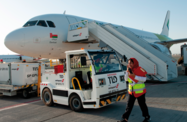The government is banking on a multi-billon dollar investment programme to create a new transport grid that will serve as the backbone to Muscat’s plans to diversify and expand the economy, bringing the country’s many urban and economic centres closer together.
Strengthening the transport infrastructure is one of the key priorities of the government, which is allocating $14.8bn under its eighth Five-Year Development Plan – covering 2011-15 – to expand the national network of land, sea and air transport. Central to this programme is improving interconnectivity, linking up existing transport nodes and developing new roads, airports and harbours to facilitate freight and passenger movement. Such is the programme’s importance that the funding allocated for capital works accounts for almost half of the five-year plan’s budget.
As one of the largest countries in the region, with coastlines on both the Gulf of Oman and the Arabian Sea and vast tracts of difficult terrain in between urban centres, it has often proved difficult to move freight quickly. Given that Oman has a substantial and growing mining industry and hydrocarbons sector, the transport of heavy cargo is central to the economy.
To this end, the Ministry of Transport and Communications (MoTC) has been rolling out a series of tenders for new road projects. The latest tender covers the construction of the 265-km Batinah Expressway. The MoTC has already awarded some of the construction contracts for the $2.6bn highway, and intends to announce the project consultant in late October, having issued the invitation for bids at the end of August.
The contract for one section of the expressway was sealed in mid-August, with Malaysia-based WCT, a construction and property development firm, being awarded a $320m contract. WCT will partner with the Oman Roads Engineering Company to construct a 44.75-km section of the four-lane highway. Work on the project, is forecast to take 36 months.
The MoTC has also commissioned a number of airport projects. Muscat will get a new international aviation centre, while the majority of the large urban centres will be linked by air once construction and technical work is completed. On September 1, Salim Bin Nasser Al Oufi, the chairman of the Public Authority for Civil Aviation, told reporters that 60% of the new Muscat International Airport had been completed, and the first stage would be ready to process passengers and freight by the end of 2013. Work is also progressing on the airports at Salalah, Duqm, Ras Al Hadd, Adam and Sohar, with most of the projects well advanced, Al Oufi said.
Additionally, one of Oman’s largest maritime projects is gaining steam, with the port of Duqm on the Arabian Sea coast beginning initial operations in late July. Though work on the port is set to continue for another two years, the facility has started handling cargo, and its capacity is set to increase steadily as the remaining infrastructure is put in place. The Duqm port is expected to work in conjunction with the ports of Sohar and Salalah.
“One must recognise the important relationship between the three national industrial areas of Sohar, Duqm and Salalah,” said Andre Toet, the CEO of the Port of Sohar, told OBG. “We believe you can create a complementary network in Oman, with Salalah being the transit point between east and west, Sohar as the gateway for Oman and the GCC, and Duqm to become the heavy industry port with the drydock and pipeline connection from the Oman and Saudi fields to develop petrochemicals operations.”
While Oman has numerous road, air and maritime projects either planned or underway, perhaps the biggest transport development is soon to be put on the drawing board. According to Oman’s Tender Board, the bids for a $155m contract to design and consult on the construction of the country’s first major railway project will be finalised in the coming months. Nine companies are in the running for the contract, with final bids due to be submitted on October 5 after the government extended the initial deadline from July.
The government has said it intends to develop a 1000-km rail network at a cost of an estimated $5bn, with the first trains set to run by 2018. The line will stretch from the northern border with the UAE down to Salalah in the far south, with branch lines connecting to other major economic centres on the Gulf of Oman.
Currently, most of the projects being carried out are running on schedule. However, as the present five-year plan comes to term, pressure to ensure projects are completed on time will increase.

